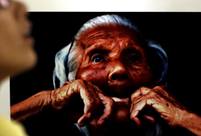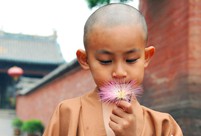

 |
| Muslims worship at a mosque in Urumqi, capital of the Xinjiang Uygur autonomous region, on Monday.[WANG ZHUANGFEI/CHINA DAILY] |
China's religious followers are becoming younger, with more than half of worshippers under 60 years old, according to a report released on Tuesday.
The China Religious Survey, conducted by researchers at Renmin University of China, found that the age range of the country's religious followers has undergone profound changes over the past decades as now a majority of believers are under 60 years old, with Islam having the largest number of followers under 30.
The researchers polled 4,383 religious venues in 243 counties or districts across the country between the second half of 2013 and the first half of 2015.
"However, people with a low degree of education remain a dominant group among all the followers, with only 5 percent of the followers having college degrees or above," said Wei Dedong, vice-dean of the school of philosophy at the university and a leading researcher.
More than 43 percent of religious followers received primary school education or less.
The survey focused on the five most influential religions in China: Buddhism, Taoism, Protestantism, Catholicism and Islam.
Meanwhile, a majority of the clergy are now aged between 30 and 60.
Of the leaders of religious venues, 21 percent are women and 15 percent have bachelor's degrees or higher.
The research showed that the clergy generally have incomes far lower than the local average, which is quite different from the public perception that religious venues can generate lots of revenue through donations.
The average monthly allowance for clergy in religious venues was only 506 yuan ($81), according to the report. The situation is even worse for Buddhist monks, who have an average allowance of 397 yuan per month.
The clergy's income mainly comes from donations, admissions, and allowances from the local governments, the policies of which vary from place to place.
The report also shows that 41 percent of religious venues have not purchased pension insurance for their clergy, and 26 percent of the venues have not purchased medical insurance.
Buddhism remained the religion with the strongest influence in China, and it recorded the largest average yearly donation of 41,000 yuan for each temple, according to the report.
It is also the religion that places the strongest emphasis on using the Internet to reach out to followers, with 14 percent of Buddhist temples having resorted to the Internet.
In one particular case, Venerable Master Xuecheng, president of the Buddhist Association of China, has maintained the habit of interacting with followers on his Sina Weibo account for more than five years.
"Quite surprisingly, more than 11 percent of Taoist temples have conducted international exchanges, the highest ratio among the five religions," he said.
"It indicated that Taoist philosophies are being increasingly studied in the world, and foreigners are increasingly willing to come to China to learn more about the religion," he said.
 Campus belle in HK goes viral online
Campus belle in HK goes viral online Lugou Bridge in 78 years: July 7 incident
Lugou Bridge in 78 years: July 7 incident Get ready for the world's most thrilling water rides
Get ready for the world's most thrilling water rides Evolution of Chinese beauties in a century
Evolution of Chinese beauties in a century Creative graduation caps of ‘vigorous elves’
Creative graduation caps of ‘vigorous elves’ Typhoon class strategic Submarine in photos
Typhoon class strategic Submarine in photos Japan’s crimes committed against "comfort women"
Japan’s crimes committed against "comfort women" Legendary life of a bee-keeping master in Hainan
Legendary life of a bee-keeping master in Hainan 4-year-old cute 'monk' spends summer holiday in temple
4-year-old cute 'monk' spends summer holiday in temple Top 10 most competitive Chinese cities in Belt and Road Initiative
Top 10 most competitive Chinese cities in Belt and Road Initiative Top 10 travel destinations in the world
Top 10 travel destinations in the world Xi talks peace at war memorial
Xi talks peace at war memorial Vietnam-US bond less rosy than it appears
Vietnam-US bond less rosy than it appears Furry funeral
Furry funeral Infrastructure investment boosted to stabilize growth
Infrastructure investment boosted to stabilize growth Day|Week